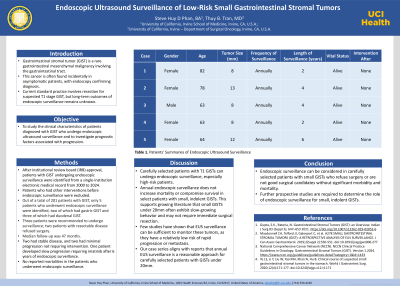Tuesday Poster Session
Category: General Endoscopy
P4136 - Endoscopic Ultrasound Surveillance of Low-Risk Small Gastrointestinal Stromal Tumors
Tuesday, October 29, 2024
10:30 AM - 4:00 PM ET
Location: Exhibit Hall E

Has Audio
- SP
Steve Huy D. Phan, BS
University of California Irvine School of Medicine
Irvine, CA
Presenting Author(s)
Steve Huy D. Phan, BS1, Thuy Tran, MD2
1University of California Irvine School of Medicine, Irvine, CA; 2University of California Irvine Health, Orange, CA
Introduction: Gastrointestinal stromal tumor (GIST) is a rare gastrointestinal mesenchymal malignancy that frequently involves the gastrointestinal tract. These tumors are often found incidentally in asymptomatic patients, with endoscopy confirming diagnosis. Current standard practice includes resection for suspected T1 stage GIST, but long-term outcomes of endoscopic surveillance remain unknown.
Case Description/Methods: A retrospective review of a single institution database was conducted for patients with GIST who were evaluated at a tertiary academic center from 2000 to 2024. Out of 201 patients, 5 patients with resectable disease underwent endoscopic surveillance only (two gastric, three duodenal GISTs). Three patients were recommended to undergo surveillance in lieu of surgical resection as the lesions were subcentimeter (< 1 cm). Two patients with resectable disease refused surgery, hence elected for endoscopic surveillance: one denied surgery due to concurrent treatment of hepatitis C at the time of diagnosis, and one refused surgery due to complex Whipple procedure for complete resection. The median follow-up was 47 months. Of the 5 patients who underwent endoscopic surveillance, two had stable disease, and two had minimal progression not requiring intervention. One patient developed slow progression requiring imatinib after 6 years of endoscopic surveillance. No reported mortalities in the patients who underwent endoscopic surveillance.
Discussion:
Carefully selected patients with T1 GISTs can undergo endoscopic surveillance, especially high-risk patients. Annual endoscopic surveillance does not increase mortality or compromise survival in select patients with small, indolent GISTs. This supports growing literature that small GISTS under 20mm often exhibit slow-growing behavior and may not require immediate surgical resection. Few studies have shown that endoscopic surveillance can be sufficient to monitor these tumors, as they have a relatively low risk of rapid progression or metastasis. Our case series align with reports that annual endoscopic surveillance is a reasonable approach for carefully selected patients with GISTs under 20mm.
Conclusion:
Endoscopic surveillance can be considered in carefully selected patients with small GISTS who refuse surgery or are not good surgical candidates without significant morbidity and mortality. Further prospective studies are required to determine the role of endoscopic surveillance for small, indolent GISTs.
Note: The table for this abstract can be viewed in the ePoster Gallery section of the ACG 2024 ePoster Site or in The American Journal of Gastroenterology's abstract supplement issue, both of which will be available starting October 27, 2024.
Disclosures:
Steve Huy D. Phan, BS1, Thuy Tran, MD2. P4136 - Endoscopic Ultrasound Surveillance of Low-Risk Small Gastrointestinal Stromal Tumors, ACG 2024 Annual Scientific Meeting Abstracts. Philadelphia, PA: American College of Gastroenterology.
1University of California Irvine School of Medicine, Irvine, CA; 2University of California Irvine Health, Orange, CA
Introduction: Gastrointestinal stromal tumor (GIST) is a rare gastrointestinal mesenchymal malignancy that frequently involves the gastrointestinal tract. These tumors are often found incidentally in asymptomatic patients, with endoscopy confirming diagnosis. Current standard practice includes resection for suspected T1 stage GIST, but long-term outcomes of endoscopic surveillance remain unknown.
Case Description/Methods: A retrospective review of a single institution database was conducted for patients with GIST who were evaluated at a tertiary academic center from 2000 to 2024. Out of 201 patients, 5 patients with resectable disease underwent endoscopic surveillance only (two gastric, three duodenal GISTs). Three patients were recommended to undergo surveillance in lieu of surgical resection as the lesions were subcentimeter (< 1 cm). Two patients with resectable disease refused surgery, hence elected for endoscopic surveillance: one denied surgery due to concurrent treatment of hepatitis C at the time of diagnosis, and one refused surgery due to complex Whipple procedure for complete resection. The median follow-up was 47 months. Of the 5 patients who underwent endoscopic surveillance, two had stable disease, and two had minimal progression not requiring intervention. One patient developed slow progression requiring imatinib after 6 years of endoscopic surveillance. No reported mortalities in the patients who underwent endoscopic surveillance.
Discussion:
Carefully selected patients with T1 GISTs can undergo endoscopic surveillance, especially high-risk patients. Annual endoscopic surveillance does not increase mortality or compromise survival in select patients with small, indolent GISTs. This supports growing literature that small GISTS under 20mm often exhibit slow-growing behavior and may not require immediate surgical resection. Few studies have shown that endoscopic surveillance can be sufficient to monitor these tumors, as they have a relatively low risk of rapid progression or metastasis. Our case series align with reports that annual endoscopic surveillance is a reasonable approach for carefully selected patients with GISTs under 20mm.
Conclusion:
Endoscopic surveillance can be considered in carefully selected patients with small GISTS who refuse surgery or are not good surgical candidates without significant morbidity and mortality. Further prospective studies are required to determine the role of endoscopic surveillance for small, indolent GISTs.
Note: The table for this abstract can be viewed in the ePoster Gallery section of the ACG 2024 ePoster Site or in The American Journal of Gastroenterology's abstract supplement issue, both of which will be available starting October 27, 2024.
Disclosures:
Steve Huy Phan indicated no relevant financial relationships.
Thuy Tran indicated no relevant financial relationships.
Steve Huy D. Phan, BS1, Thuy Tran, MD2. P4136 - Endoscopic Ultrasound Surveillance of Low-Risk Small Gastrointestinal Stromal Tumors, ACG 2024 Annual Scientific Meeting Abstracts. Philadelphia, PA: American College of Gastroenterology.
